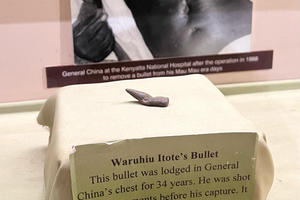British colonial rule in Kenya has a long and brutal legacy, lasting from 1888 until 1960. Its eventual dissolution can be partly attributed to the actions of the Mau Mau Rebellion, which was conducted by guerrilla fighters who resisted British rule in the forests of central Kenya in the 1950s.
One of the most iconic artifacts from this era, which can be found in Nairobi National Museum, is a bullet which was fired by the British on Mau Mau fighter Waruhiu Itote in 1954 and which stayed with him for the next 34 years. Itote, also known as General China, was a major player in the armed struggle against the British, and nearly paid for it with his life during a skirmish on the slopes of Mount Kenya.
After the bullet failed to kill him, Itote was captured and sentenced to death by the British, although his sentence was subsequently commuted to life imprisonment. He was freed in 1962 by the first president of independent Kenya, Jomo Kenyatta.
Itote thought that the British bullet, which nearly killed him, had exited his body, but it later turned out that he had been carrying it with him ever since. It was eventually surgically removed by Professor Peter Odhiambo in 1988 and has been on display at the Nairobi National Museum since 2010.
The bullet is located in the museum’s Kenyan History hall on the second floor, and is surrounded by an exhibit detailing the Mau Mau Rebellion and its aftermath.
